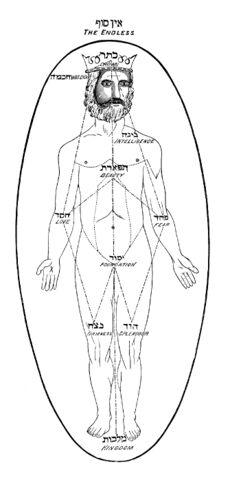Adam Kadmon

In the Kabbalah, the the divine archetype of man and woman is known as Adam Kadmon, literally “Primordial Man.” He is the original archetype of man—an ideal conception of man, the first to be created and the model for all future humanity. He is the spiritual man, the heavenly man, who contains in perfect form all the divine attributes.
Some Kabbalists teach that when the sefirot emanated from Ein Sof, they first took the form of Adam Kadmon. Kabbalists describe him as “the concealed shape of the Godhead itself.”[1] Adam Kadmon is androgynous; in him the male and female forces are in complete harmony and balance.
Kabbalists usually depict Adam Kadmon so that we are viewing his back. This is based on the passage from Exodus where Moses asks God to show him his glory but the LORD reveals only his back to Moses, saying: “Thou canst not see my face: for there shall no man see me and live.... And thou shalt see my back parts: but my face shall not be seen.”[2]
Adam and Adam Kadmon
The Adam of the Garden of Eden was the anthropological counterpart of Adam Kadmon. Before he sinned, Adam’s body was spiritual and ethereal. After he fell from his divine state in Eden, Adam took on a material body. But Adam Kadmon never descended below the realm of heavenly perfection.
I believe that Adam Kadmon was the primordial image and likeness of God in which we were made and that his body is the blueprint for the bodies of all sons and daughters of God. We have strayed from that blueprint, compromising our bodies by our negative thoughts, feelings, words and deeds. But the original matrix of perfection, the divine image and likeness, is there, sealed in our Higher Self.
Kabbalists say we can return to that divine image. Daniel Matt writes:
According to Genesis 1:27, the human being is created in the image of God. The sefirot are the divine original of that image. As Primordial Adam, they are the mythical paragon of the human being, our archetypal nature. The human race has lost this nature, but if one were to purify himself, he would reconnect with the sefirot and become a vessel for them. This is what the Patriarchs attained and, to a greater degree, Moses.[3]
For more information
Elizabeth Clare Prophet, Kabbalah: Key to Your Inner Power
Sources
Pearls of Wisdom, vol. 37, no. 40.
Elizabeth Clare Prophet, Kabbalah: Key to Your Inner Power, pp. 73, 75–76.
